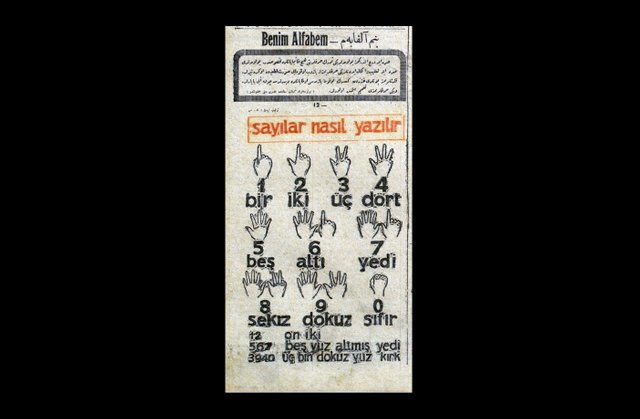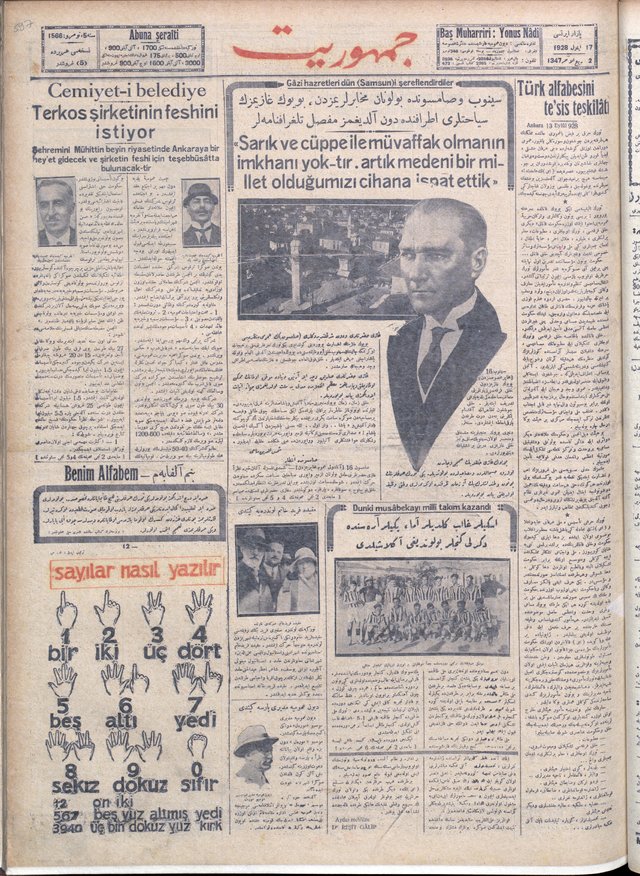Today in 1920s Turkey: 17 September 1928 (Disseminating Knowledge of the New Alphabet)

(My Alphabet #12, Cumhuriyet or “Republic,” 17 September 1928, no. 1566, page 1.)
English
My Alphabet: How to Write Numbers
These sequentially included panels are only intended for those who have no familiarity with the new Turkish letters. Those who follow and complete the panels in their correct order will fully learn to read and write the new Turkish letters. Our readers will do good if they cut these out of the newspaper and give them to those who don’t know how to read and write. And [this way] they will have spread [knowledge of] our new letters.
(The right to publishing these panels together as a book are protected.)
Türkçe
Benim Alfabem: Sayılar Nasıl Yazılır
Sırayla dercettiğimiz bu levhalar yeni Türk harflerini hiç tanımayanlara mahsustur. Levhaları sıra ile takip ve ikmal edenler yeni harflerimizle yazıp okumayı suret-i kat’iyede öğrenirler. Karilerimiz bunları gazeteden keserek okuma yazması olmayanlara verirlerse çok iyi yaparlar. Ve yeni harflerimizi taammüm etmiş olurlar.
(Bu levhaların kitap halinde neşri hakkı mahfuzdur.)
Comments:
This is the twelfth installment in a series of panels issued by Cumhuriyet or “Republic” aimed at teaching the new alphabet to the daily newspaper’s readers. In August 1928 a new Turkish alphabet was devised based on the Latin letters. This newly minted phonetic alphabet was slated to replace the Arabic alphabet (used to transcribe the Turkish language since the tenth century) in all official communications, signage, publications, contracts, etc. on 1 December of that very year. Citizens were expected to spend time learning the new alphabet during the three months leading up to this definitive reform. Newspapers and journals were especially invested in making sure their readers were staying on course for this transition because if their readers do not learn the letters they will stop buying the newspapers once they become illegible in December. Thus, there was financial imperative informing the newspapers’ initiatives aimed at helping their consumers learn the new alphabet.
“How to Write Numbers” is the twelfth installment in Cumhuriyet’s multi-episodic mini-series called “My Alphabet.” The explanation of the program and instructions on how to work through the lessons is included at the top in Arabic/Ottoman letters and below are images paired with Turkish words inscribed in the new “Turkish Alphabet.” The directions cleverly instruct readers to cut these panels out of the newspaper, collate them into booklets, and give them away to those who still need to learn the new letters. In addition to featuring these types of “lessons” newspapers also included mixed-alphabet content during these months. For example, the entire front page of this issue of Cumhuriyet (below) demonstrates various ways in which the new letters were employed in the transcription of headlines and the like at this early phase in the adoption process.
The build-up and effects of alphabet reform, of course, were most visible in the popular press. As such, the issue of alphabet reform and functional efforts to support its mass adoption are recurring themes in content previously covered by Today in 1920s Turkey. Examples of materials related to this major reform can be accessed below:
Today in 1920s Turkey: 3 September 1928 (Famous Person Charles Dickens)
21. Today in 1920s Turkey: 24 September 1928 (The War on Ignorance)
29. Today in 1920s Turkey: 29 October 1928 (Happy Republic Day, Turkey!)
47. Today in 1920s Turkey: 3 January 1929 (A New Alphabet for the New Year)

(Entire front page, Cumhuriyet or “Republic,” 17 September 1928, no. 1566, page 1. Atatürk Library, Istanbul.)
This article has been updated and modified from its first iteration published right here on Steemit on 17 September 2016. For the original version see:
20. Today in 1920s Turkey: 17 September 1928 (Disseminating Knowledge of the New Alphabet)